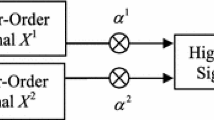Abstract
Orthogonal frequency division multiplexing (OFDM) is a common technique in multi carrier communications. One of the major issues in developing OFDM is the high peak to average power ratio (PAPR). Golay sequences have been introduced to construct 64-quaternary amplitude modulation (QAM) code for the OFDM, reducing the peak-to-mean envelope power ratio. In this paper we have considered the use of coding to reduce the peak-to-mean envelope power ratio (PAPR) for OFDM systems. By using QPSK and BPSK Golay sequences, 64-QAM sequences with low PAPR are generated and analyzed.


Similar content being viewed by others
References
Van Nee, R., & de Wild, A. (1998). Reducing the peak-to-average power ratio of OFDM. IEEE Vehicular Technology Conference, 3, 18–21.
Li, X., & Cimini, L. J. (1998). Effects of clipping and filtering on the performance of OFDM. IEEE Communication Letter, 2(20), 131–133.
Slimane, S. B. (2000). Peak-to-average power ratio reduction of OFDM signals using pulse shaping. In IEEE Global Telecommunications Conference (Vol. 3, pp. 1412–1416).
Wilkinson, T. A., & Jones, A. E. (1995). Minimization of the peak-to-mean envelope power ratio of multicarrier transmission scheme by block coding. In IEEE VTC’95, Chicago (Vol. 2, pp. 825–829).
Röbing, C., & Tarokh, V. (2001). A construction of OFDM l6-QAM sequences having low peak powers. IEEE Transaction on Information Theory, 47(5), 2091–2094.
Golay, M. J. (2001). Complementary series. IRE Transaction on Information Theory, 7(5), 82–87.
Houshu, C. H. (2007). Construction of 16-QAM and 64-QAM OFDM codes with low PAPR and large Euclidean distance. The Institute of Electronics, Information and Communication Engineers, Transaction Communication, E90-B (8), 1998–1996.
Bai, G., Zhong, Z., Xu, R., Wang, G., Qin, Z. (2012). Golay complementary sequences and Reed-Muller codes based PAPR reduction for relay networks with superimposed training. In ICSP 2012 Proceedings.
Huang, S. C.-H., Wu, H.-C., Chang, S. Y., Liu, X. (2010). Novel sequence design for low-PMEPR and high-code-rate OFDM systems. IEEE Transactions on Communications, 58(2), 405–410.
Author information
Authors and Affiliations
Corresponding author
Rights and permissions
About this article
Cite this article
Uppal, S., Sharma, S.K. & Singh, H. Analysis of 64 QAM Golay Codes with Low Peak to Average Power Ratio for OFDM Systems. Wireless Pers Commun 80, 1027–1034 (2015). https://doi.org/10.1007/s11277-014-2068-5
Published:
Issue Date:
DOI: https://doi.org/10.1007/s11277-014-2068-5




